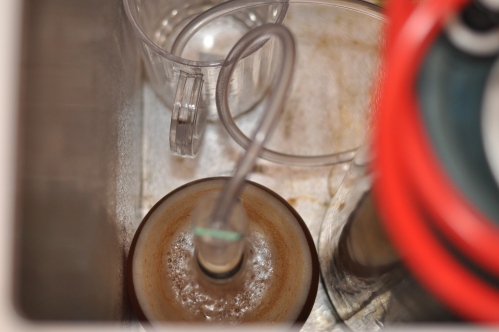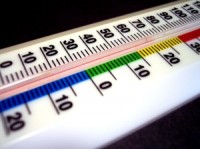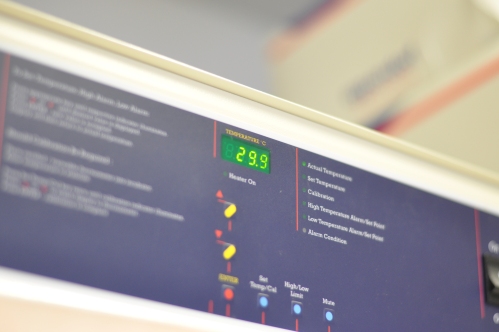Besides yeast health, controlling fermentation temperatures is one rule that homebrewers (and professional brewers) should always follow. When you buy a packet of yeast, there is a suggested range of temperatures that fermentation should occur. The yeast company determines this range so the customer has the best chance of making a beer of good quality. This range varies considerably between strains. For example, Wyeast 1028 (London ale) has a recommended range of 60°F to 72ºF while Wyeast 2308 (Munich Lager) has a range of 48°F to 56°F. Some strains can even go as high as 95°F (WYeast 3724 – the dupont strain).
What are the Effects of Temperature on Beer?
Fermenting at higher temperatures produces unwanted flavors in beer due to the increased metabolic activity. Off flavors such as fruity esters and solventy higher order alcohols, are generated. Acetaldehyde (green apple), in particular, is produced at a much higher rate during increased fermentation temperatures and is one of the most common faults in homebrewed beer. Fermenting below a yeast’s range will decrease these metabolites, but you also risk a sluggish fermentation, poor start to fermentation, and possible attenuation issues. The first generation of yeast is also susceptible to high fermentation temperatures as further pitches will suffer in quality.
How Does Temperature Affect Yeast?
As eluded, metabolic activity increases along with yeast growth at higher temperatures. Metabolism will proceed at such a high rate that the cell cannot keep up with byproducts produced from elevated temperatures. Also, heat (even a swing of 4°F) is a stress factor and causes proteins which are important for wort fermentation to unfold within the yeast cell. To counter this, the cell expresses a class of proteins called heat shock proteins. These are basically molecular chaperones that guide proper protein folding after translation and expressed to a high degree under heat stress. At higher temperatures there is also some DNA damage that occurs and is dealt with by cellular DNA repair machinery. The question then becomes, would you rather have the cell repair damage or make great beer for you to drink?
What does this mean for the Homebrewer?
Control your fermentation temperature within the given range as consistently and stably as you can. Try avoid any swings in temperature, especially during the first three days of fermentation. There are a couple of ways to do this:
- Find a cool spot that stays at a constant temperature. This is the easiest method if you happen to have a cool basement.
- Plastic tub/wet t-shirt/fan method. This technique is a bit more complex. The benefit is this is approachable to homebrewers on a budget. The downside is getting a consistent temperature is very hard. Basically you put the primary fermentation in a tub filled with 5 inches of cold water. Wrap the fermentor in a t-shirt with a fan blowing on it. The t-shirt acts as wick, pulling up water and the fan serves to evaporate any heat coming from the fermentation. You can add frozen water bottles to regulate the temperature even more.
- Fermentation chamber. The best method, but most expensive. It involves using either a chest freezer or refrigerator set at constant temperature with a digital temperature controller.
You can measure the temperature of the fermentation by using a heat sensitive sticker. However, the most accurate method is using a thermowell to place a thermometer directly in the fermenting wort. The latter is obviously more expensive than the former. Whatever method you choose from above, keep in mind that fermentation is an exothermic reaction and will generate heat. Fermentation temperatures could rise 5-10°F above ambient. This article in Brew Your Own is great for controlling fermentation temperature.
The Experiment
I will be teaching a class on yeast and homebrewing at the end of August at Brooklyn Homebrew, and since I touch on fermentation temperatures in the lecture I thought this would be a good experiment to share with the class. The owners of Brooklyn Homebrew, Benjamin and Danielle, donated the supplies and are simply awesome. Data collection will be similar to my experiment on yeast pitching rates by taking a flavor profile poll on each beer that is brewed. The goal is not necessarily to prove that high fermentation temperatures can affect beer (this is well-known), but rather to highlight differences between samples fermented at different temperatures. I chose WYeast 1388 (Duvel strain) primarily for its wide range of suggested fermentation temperature.
Experiment conditions:
- Same wort produced for each sample.
- Same yeast and cell number (50 billion cells) used for each sample.
- Style of beer: Belgian Blonde Ale
- Yeast strain: Wyeast 1388
- Each sample gets aerated with pure oxygen for 30 seconds.
- Pitching temperature will be different for each, but with my setup I have no way of controlling this. Pitching temperature is also important and may need to be questioned in another experiment.
- I will not be pitching at the same time. I will need to bring my high temp sample into work and pitch then (1 hour lag time).
- Fermentations will occur for one week and bottle conditioned for another three.
Samples:
1) Fermentation temperature of 60°F. This fermentation will occur in my chest freezer that is controlled by a digital temperature controller.

2) Fermentation temperature of 72-75°F. This sample is subject to most variability in temperature as I will be using a water bath and ice bottles.

3) Fermentation temperature of 86°F. This sample will be brought into my lab and placed into a constant 30°C (86°F) yeast incubator.
Beer (4.5 gallon batch):
- 6 pounds of golden light DME
- 2.0 ounces of Styrian Goldings at 60 minutes (3.8% AA for 27 IBUs)
- 1.0 ounce of Czech Saaz at 0 minutes (flameout)
- 1 whirlfloc tablet
- 1/2 tsp of yeast nutrient
Victuals:
- OG: 1.059
- IBUs: 27 (Tinseth)
For more scientific reading on the effects of temperature on beer fermentation I have two papers that are worth looking at. Olaniran et al., published an interesting article studying fermentation temperature effects on beer color, foam stability, flavor profiles, and aroma profiles. While there was no effect on the color of the beer, there were differences in volatile compounds in the headspace of the beer. Yeast viability decreased at higher temperatures and tasters reported that the high fermentation samples tasted more medicinal. The second paper is a bit older but describes the formation of esters during fermentation. Quoting Peddie et al.:
“Temperature: When temperature is elevated, the concentration of esters produced during the fermentation is also increased. For example, 15°C temperature increase from 1O°C to 25°C can result in 75% increase in ester concentration. This increase in temperature may make the membrane more fluid and so affect the activity of the AAT enzyme, if it is membrane bound. An increase in membrane fluidity may allow more ester to diffuse into the medium. AAT is also known to be unstable at higher temperatures. However, the higher temperature may simply increase enzyme activity. Engan and Aubert have shown that the effect of temperature differs with both ester type and temperature range.”





Jason,
I’m looking forward to the results. One suggestion on the oxygenation. You could aerate the collective wort before you divide it into the individual samples. That’s what I have done to keep the O2 levels the same. The challenge would be the sample you want to bring to work since you plan to pitch that later than the other samples.
Good call – I should have done this. Actually, oxygenating in one gallon fermentors produces quite the mess.
Awesome description of the importance of fermentation temperatures. This was one of the biggest changes from my beer being drinkable to awesome.
Definitely keep us posted on the results!
Awesome description of the importance of fermentation temperatures for the homebrewer. Paying attention to fermentation temperatures was a big factor in my beer going from drinkable to awesome.
Keep us posted with the results!
Sooner or later I would like to start doing experiments like this for myself. I shall keep up on your results. Great blog man!
I’m going to be a bit of a contrarian, or perhaps even a curmudgeon, and take umbrage with the following statement: “Fermenting at higher temperatures produces unwanted flavors in beer due to the increased metabolic activity. Off flavors such as fruity esters and solventy higher order alcohols, are generated.”
The yeast strain temperature recommendations (and even style recommendations) are just that–recommendations. Rather than thinking in terms of “right yeast strain” or “right temperature,” I’m more interested in learning the flavor/aroma contributions of several yeast strains across various conditions, and then picking a strain and temperature based on the flavors or aromas I want to coax out of the beer. Sometimes those “off flavors” (or products of metabolic stressing) are exactly what I need to get the taste profile I’m imagining in the beer I’m trying to make. For some “yeast-driven” beer styles, under-pitching, under-oxygenating, or increasing the temperature is exactly the “right” thing to do. We know, for example, that several Belgian brewers use the strain (nearly) equivalent to Wyeast 3787/WLP530. A couple of those brewers are known to use the yeast at temperature’s well out of the recommended range, and they make world-class beers. Likewise, White Labs has recently published data online that blind tasters preferred a Hefeweizen where the yeast was greatly underpitched relative to recommendations made on most online homebrewing forums.
In summary, best “standard operating procedures” for laboratory yeast growth isn’t necessarily optimal conditions for flavor/aroma production. Furthermore, it might be worth keeping in mind that many of the standard operating procedures now being preached were designed by people trying to make beer styles with almost no yeast contribution at all (e.g. American hop-driven and German lager styles).
“I’m going to be a bit of a contrarian, or perhaps even a curmudgeon”
I don’t think you’re being a contrarian. Actually, you are (or will be) supporting the way I feel about temperature ranges that are given for individual yeast strains.
“The yeast strain temperature recommendations (and even style recommendations) are just that–recommendations.”
Couldn’t agree with you more. Like I said, these are recommendations that companies determine so they can give a consistent product. The range of temps in my experiment gets exactly at what you’re saying. Perhaps the 86F sample will produce an awesome beer? That is what I (and the class) would love to find out. I’m hoping when I post the results I can discuss brewing beer outside of recommended yeast ranges.
“For some “yeast-driven” beer styles, under-pitching, under-oxygenating, or increasing the temperature is exactly the “right” thing to do.”
I’ve already suggested this in an pitching rate experiment. Did you read it? Here it is:
http://sciencebrewer.com/2012/03/02/pitching-rate-experiment-part-deux-results/
However, I don’t think you need to take umbrage with my statement about metabolic activity and off-flavors. It’s been proven, scientifically and professionally, the high fermentations produce off-flavors due to high metabolic activity. However, it’s up to the consumer whether they like those off-flavors or not.
Something that has worked well for me is fermenting with a carboy immersed in water. Not a small amount of water and a t-shirt; fully immersed. I use my hot liquor tank–a 10 gallon Rubbermaid. If the room temperature fluctuates around the right temperature, the water will moderate the swings. If it’s a bit on the warm side, I’ll remove some water and replace it with cooler water as needed. On the other hand, if the ambient temperature is too cool, I add a $20 submersible aquarium heater too keep the yeast toasty warm. I make Belgians in the dead of Maine winter that way.
I do the same down here in FL during the “winter” when brewing a scotch ale. My swimming pool stays a constant 64 F. I just encase the fermenter in a construction contractor grade garbage bag (keep the UV out) and plop in on a step of the pool. I can only submerge 2/3 of the carboy, otherwise the buoyant force becomes too high and the circulating pool water causes the fermentor to slowly “drift” to the step edge! Was thinking about making a floating foam “island” with a hole large enough to accomodate the carboy and mount one of those carboy slings and let it hang through the hole to cradle the carboy. Then I could just place the carboy in the sling and let Fermentation Island drift in the pool 🙂
This is probably the most interesting solution to controlling fermentation temps that I’ve ever heard!
Pingback: Online Home Brew: 19 Useful Websites For Home Brewers
Jason,
I am working on a independent study for school in which i am performing a very similar experiment involving the effects of fermentation temperature. Are your results posted anywhere? I am very interested to see what you found and how the flavor profiles were affected so i can compare your results to mine once my experiment is finished.
Awesome that you are doing this experiment. Let me know how it goes. As for the results I have them and intend to post them. However, I’ve been swamped in the past 3 months moving my family for a job that I have taken in PA. I will post soon though (1-2 weeks).
J
Pingback: Back in Business Oatmeal Cookie Ale | Brew Science – Homebrewing Blog
Pingback: Fermentation Temperature Experiment: Results | Brew Science – Homebrewing Blog
Pingback: Yeast effects on beer brewingAvogadro Brewery